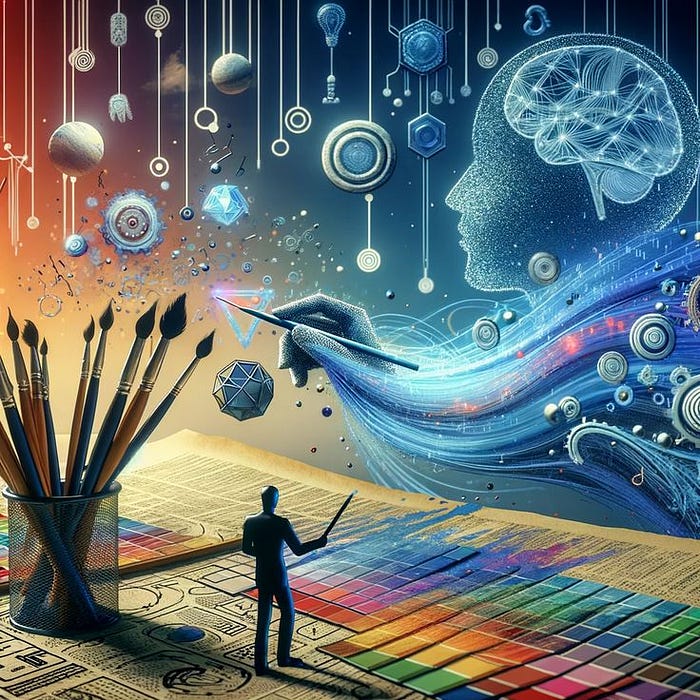
Welcome back to the Graphic Design Theory series! In Episode 1, we explored why graphic design is essential, shaping everything from brand identity to user experiences. Today, we’re tackling a big question in the design world: Can AI replace graphic designers?
With the rise of AI tools capable of generating everything from layouts to logos, some people worry that human creativity is becoming obsolete. But while AI has powerful capabilities, it can’t replace the unique insights, emotional intelligence, and storytelling skills that human designers bring. Let’s dive into why AI is a tool for designers — not a replacement — and how both can work together.
What AI Brings to Graphic Design
AI has undeniable strengths that enhance the design process, especially when it comes to speed, data processing, and consistency. Here’s what AI brings to the design table:
- Efficiency and Speed: AI tools can handle repetitive tasks like resizing images, creating layout options, and applying filters at lightning speed, saving designers valuable time.
- Data-Driven Insights: AI can analyze trends and user preferences, giving designers a data-backed foundation to create visuals that resonate with specific audiences.
- Tools That Inspire: AI-powered software like Adobe Sensei, DALL-E, and Canva’s AI design tools allow designers to quickly explore different ideas and layouts, sparking new creative directions.
However, while AI tools are impressive, they’re best suited as collaborators in the design process, handling technical details and providing inspiration rather than driving creative decisions.
Where AI Falls Short: The Human Element in Design
AI may excel in automating tasks, but it lacks the irreplaceable human qualities that make design a powerful art form. Here’s why human designers bring something to the table that AI simply can’t replicate:
- 1. Creativity and Innovation
Creativity isn’t just following patterns; it’s about breaking them, pushing boundaries, and creating something new. AI is trained on existing data, which limits its ability to invent or innovate beyond what’s already been done.
- Example: When creating a unique brand identity, human designers consider what will make the brand stand out from competitors, something AI-generated designs can struggle to capture.
- 2. Emotional Intelligence and Empathy
Great design is about connecting with people, and human designers bring empathy to their work. They can understand the emotions, cultural nuances, and personal experiences of their target audience, crafting designs that resonate on a deeper level.
- Example: Designing a logo for a non-profit requires more than choosing colors and shapes. Human designers tap into the organization’s mission, ensuring the design conveys trust, compassion, and impact.
- 3. Storytelling
Design isn’t just visual — it tells a story. Designers weave narratives that align with a brand’s mission, values, and vision. AI can generate visuals, but it can’t tell a meaningful story that connects with audiences on an emotional level.
- Example: When designing for a brand, human designers think about the long-term narrative, crafting visuals that speak to the brand’s growth and evolution, something AI can’t fully understand.
- 4. Aesthetic Intuition and Trend Awareness
Designers have an innate “eye” for aesthetics, adapting to trends and intuitively understanding what will resonate with audiences. While AI operates based on historical data, human designers keep a finger on the pulse of emerging trends and adapt in real-time.
- Example: Human designers can sense when certain colors, shapes, or fonts are becoming dated, adjusting their style accordingly — a flexibility that AI lacks.
How AI and Designers Work Together
While AI won’t replace graphic designers, it can be a powerful partner. By handling time-consuming tasks, AI allows designers to focus on high-level creative work. Here’s how AI complements designers:
- Boosting Productivity: AI can quickly generate design variations or analyze large sets of data, allowing designers to quickly explore ideas and test concepts.
- Enhancing Creativity: AI-generated mood boards, color suggestions, and layout ideas provide designers with a springboard, inspiring fresh ideas they might not have considered otherwise.
- Examples of Successful AI-Designer Collaboration:
— Color Scheme Suggestions: AI tools can analyze color harmonies and suggest palettes, but designers still choose colors based on brand identity and emotional resonance.
— Layout Variations: AI-generated layouts save time, but designers customize these based on user experience and aesthetic goals.
— Inspiration and Ideation: AI tools like DALL-E can produce concept visuals, which designers refine, bringing an irreplaceable human touch to the final result.
AI can be an invaluable tool, enhancing workflow and expanding creative possibilities, but it’s the designer’s vision, experience, and intuition that drive the final product.
The Future of Graphic Design: A Human-AI Partnership
As AI technology advances, the roles and tools of designers will continue to evolve. Future designers may need hybrid skills, blending technical AI knowledge with deep creative expertise. Rather than replacing designers, AI will likely reshape their roles, allowing them to focus on big-picture strategy, storytelling, and innovation.
Design will remain a deeply human field, rooted in creativity, empathy, and connection — qualities that no algorithm can replicate. AI may support the process, but the heart of design remains with human ingenuity.
What’s Next?
In our next episode, we’ll dive into *The Electromagnetic Spectrum* and how it affects color perception in design. Understanding color at a scientific level allows designers to make informed choices that amplify a brand’s visual impact. Stay tuned for a fascinating look at how color truly works in design!

Until next then by from Perogi👋

.png)